Chimney cleaning products: what is the best way to clean a chimney from soot
Careful operation of furnace or boiler equipment does not guarantee the absence of soot in the chimney.The issue of cleaning the chimney remains relevant all the time. To facilitate maintenance, cleaning agents for chimneys and combustion chambers are used, the effects of which are worth familiarizing yourself with. Do you agree?
We will tell you about all the effective methods and chemical compositions that remove contaminants from chimney pipes. The article we have presented has collected and presented information on methods for the prevention and destruction of tar deposits. Folk and mechanical methods of combating soot are described in detail.
The content of the article:
Causes and consequences of a dirty chimney
Combustion is a physical and chemical process, as a result of which flammable substances are oxidized and a large amount of heat is released. The fuel breaks up into fractions - part is converted into gas and rushes upward, creating thrust. Particles of unburned materials (plaque and soot) are deposited in the chimney.
The amount of deposits directly depends on the completeness of fuel combustion. With active combustion, the organic content is sharply reduced - water vapor, sulfur dioxide and carbon dioxide come out of the pipe. Heavy resins and ash settle in limited quantities.
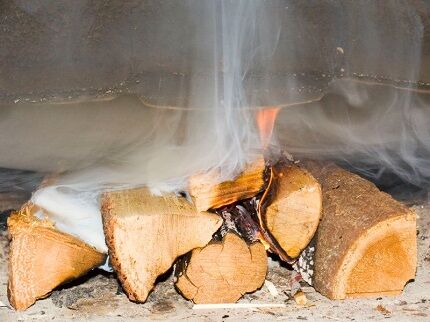
In addition to the natural processes of combustion and smoldering, the main causes of chimney blockage include:
- The use of wood with a high content of resinous substances, for example, firewood from coniferous trees. The resin forms an excellent adhesive base for soot adhesion.
- Firing a boiler or stove with poorly dried or freshly cut wood - condensation settles on the inner surface of the “smoke chamber”. Soot particles accumulate faster on wet walls.
- Using a heating device for waste disposal. Burning household waste is a complex of ethers, tarry components and non-combustible substances that contribute to the rapid contamination of the smoke channel.
- Pipe insecurity cap - deflector. From the street side, leaves can get into the chimney, birds can fly in, etc. While the furnace is idle, wasps or birds sometimes build their nests in the pipeline.
The rapid “overgrowing” of soot is the result of the unscrupulous work of the stove maker. The reduced cross-sectional area of the pipe, incorrect angle of inclination, roughness and many turns of the chimney accelerate the contamination process. Too thin walls or insufficient thermal insulation of the pipe contribute to excess condensation.

Possible consequences of a polluted channel:
- Reduced cravings. The narrowed lumen limits the free flow of smoke.Due to the accumulation of soot, the pipeline does not warm up well, which means the efficiency of the equipment decreases. It's possible tilting traction – acrid smoke begins to flow from the firebox into the room, which is dangerous for carbon monoxide poisoning.
- Possibility of fire. The soot layer can ignite - in addition to deforming the chimney, sparks and fire pose a threat to the roofing and the house as a whole.
There is a danger of fire and nearby buildings. The roofs of neighboring houses are not immune to the ingress of hot soot particles.
Signs and frequency of cleaning
The first symptoms indicating problems with the chimney appear long before serious problems.
However, you should be wary and take timely measures if:
- the color of the smoke changed from whitish, transparent to dark;
- the shade of the fire in the firebox has become dark orange, and the wood burns almost silently, without crackling;
- To maintain the usual temperature, you have to add more coal and firewood.
As the chimney becomes overgrown, difficulties arise with lighting the fireplace and stove due to the lack of oxygen coming from outside.

To avoid major cleaning or partial disassembly of the duct, the chimney should be regularly inspected and preventative maintenance performed.
Recommended timing of medical examinations:
- mandatory inspection before commissioning or after repair;
- on the eve of the heating season;
- inspection of gas boilers and furnaces for the first two years of service - twice a year, then - once a year;
- verification of ceramic, asbestos-cement and concrete pipes – once a year;
- assessment of the condition of a brick chimney – 1 time/3 months.
Regardless of the inspection indicators, stove makers advise cleaning smokers of heating and cooking appliances every 3 months, and continuous boilers - every 2 months.
Chemical reagents in the fight for purity
With regular use of industrial preparations, it will be possible to delay a major chimney cleaning. Reagents are added to the furnace and, during combustion, they release components that convert amorphous organic deposits into a solid fraction. The soot loses its adhesion to the walls and falls down. Subsequently, it is cleaned out of the firebox.
Chemicals are available in the form of briquettes, powder or liquid. The characteristics of the most popular drugs and recommendations for the best way to clean the chimney from soot are given below.
Series of products "Smoke" produced by "Ecolays"
The range of cleaning products "Smoke" of the Ecolays company is presented in three types:
- box;
- log;
- granules.
Box "Smoke" - the cleaner is easy to use and has a cumulative effect.
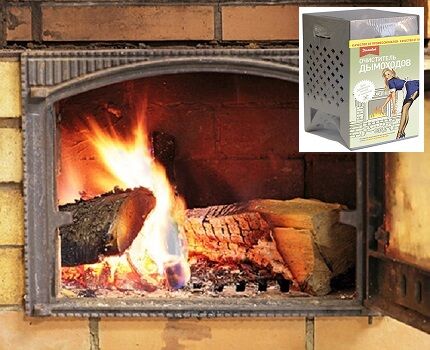
Activated carbon and metal salts, which are part of the boxed "Smoke", when burned, react with a tar deposit - moisture evaporates from the soot, the deposits become brittle and burn.
You should not count on instant results - the effect of the drug lasts another 2 weeks, a noticeable effect will occur in 2-3 months.
The “Dimovaya” log is produced in the form of a block that imitates natural wood. It is laid together with firewood when kindling. During combustion, a beautiful turquoise flame is observed - a sign that the cleaning components have entered into a thermal reaction. The advantage of using logs is aesthetics and an unusual visual effect.
Similar products: “Polishko”, log from “Vortex”, log “Chimney Sweep”.
Granular cleaner "Smoke" is designed for servicing pellet stoves and boilers. The drug is mixed with fuel granules and poured into the firebox. Suitable for use in traditional wood stoves.
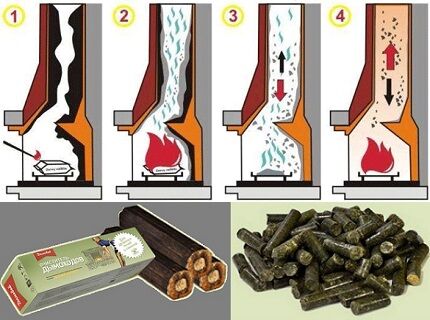
Dymovoy products have proven themselves as a means of preventing and cleaning moderate pollution.
"Kominicek" - anti-carbon chemical composition
The Czech-made drug Kominichek is available in powder form, packaged in 14 g sachets.
Features of using the cleaning reagent:
- designed to remove soot, the layer of which is up to 2 mm;
- recommended refueling dose – 1 package/1 kg of firewood;
- It is not permissible to use it with an open firebox (fireplaces) - when burning, the chemical composition emits a pungent odor.
The dosage of the furnace cleaner for preventive purposes depends on the type of furnace equipment:
- fireplace insert and local stove – 14 g;
- boiler serving one floor - 14 g;
- central heating boiler – 28 g.
The manufacturer does not recommend changing the dosage of the drug. For severe contamination, it is better to repeat the treatment twice a month. The Kominichek bag is thrown into the firebox without opening, entirely.
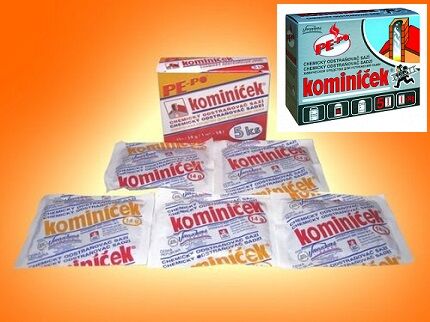
Range of cleaning products from Hanza
The Lithuanian company has developed a line of effective reagents aimed at destroying creosote - resinous components that, when in contact with water vapor, create a sticky base for soot to stick to.
Popular products from Hanza:
- "Log Chimney Sweep";
- concentrated granular preparation;
- resin cleaner in sachets;
- pellets for servicing heating devices operating on granular fuel.
Hanza purifiers contain a complex of crystals. One group of components acts as a catalyst, converting wood soot into flammable gases. Other substances produce haze at high temperatures - hot vapors destroy the structure of resin deposits.
Loose soot remover Hanza is universal. The product is suitable for fireplace inserts, solid fuel boilers, wood stoves and open fireplaces. The shelf life of the cleaner is unlimited.
The powdered reagent is easy to use - one or two measuring cups are added to the combustion chamber for fuel. At the first stage of use, to ensure good quality of cleaning with the cleaner, it is recommended to “prime” each firebox.
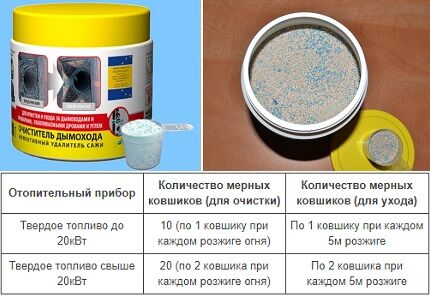
The powder is packaged in plastic containers or bags of 50 g. The volume of one bag corresponds to the capacity of a measuring cup. "Log Chimney Sweep" burns out in 2 hours, the period of action is 2 weeks. To increase efficiency, it is advisable to repeat the preventive cleaning procedure. There is no need to remove the packaging when placing it in the firebox.
Granular “Hanza” ensures cleaning not only of the chimney of a pellet boiler, but also of the burner, door glass and heat exchanger. The product is not suitable for wood and coal fired equipment.
Recommended proportions based on boiler power:
- up to 10 kW – 1 kg;
- 10-20 kW – 2 kg.
For the purpose of prevention, as 200 kg of fuel is consumed, 250 g of purifier are added.
Spalsadz - soot combustion catalyst
Spalsadz (Poland) – activator for complete combustion of tar deposits and soot. The reagent is in the form of a green powder consisting of inorganic salts. When the temperature rises to 350-600°C, the product decomposes into catalytic components that promote the decomposition of organic matter into water and carbon dioxide.
Features of the Spalsadz catalyst:
- non-explosive and non-flammable;
- does not react with ceramics, so deformation of ceramic elements is excluded;
- increases the efficiency of heating devices - fuel consumption is reduced by 20%;
- non-toxic;
- product consumption – 1-2 kg/1 t of fuel (depending on the level of pollution).
The generated heat does not “evaporate into the chimney”, and downtime for cleaning the boiler is reduced. An additional advantage of Spalsadz is the reduction of sulfur dioxide emissions into the atmosphere.
Traditional methods of chimney cleaning
Traditional methods are aimed more at preventing the formation of tar deposits. If the chimney is clearly dirty, they are ineffective, and some of them can cause a fire. Therefore, old-fashioned methods should be treated with a reasonable degree of skepticism and the remark that the main condition for cleaning is safety.
Self-cleaning: what to add to the firebox
Below are suggested methods, the implementation of which does not cause concern. Their essence boils down to the use of substances, the combustion of which improves the separation of soot from the walls of the “smoke chamber”.
Method 1. Salt. A thin layer of ordinary salt is poured onto the burning logs. Sodium chloride vapor “breaks” sticky deposits on the chimney.
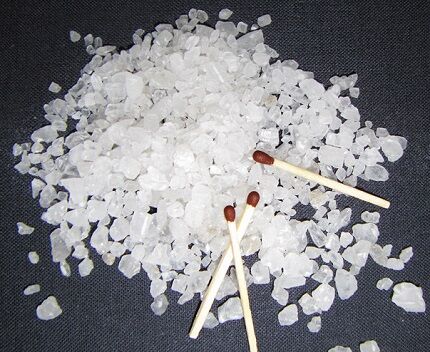
Method 2. Potato peel. An excellent and affordable tool. Potato peelings must first be dried. Depending on the size of the oven, 0.5-1 bucket of peel is added to the firebox. Alternatively, you can use the potatoes themselves, cut into slices and dried in the sun.

Method 3. Hot water. This option is suitable for initial cleaning and breaking through a heavily clogged chimney. 3-4 liters of boiling water are poured from above the pipe, carefully distributed along the walls of the channel.

Method 4. Aluminum cans. An unusual, but quite effective option for cleaning a chimney. The essence of the method is that aluminum actually burns, and not just smokes and changes color at high temperatures. It is optimal if the can burns out in 5 minutes.

Burning soot with fire is a risky option
An old way to clean a chimney is to burn aspen wood. Logs are placed in the oven and set on fire. It is necessary to achieve high, but short-term heat, which will lead to the combustion of soot.
When ignited, the furnace begins to hum, and fiery arrows can fly out of the chimney; the surrounding area is covered with white flakes. The result is a clean chimney.
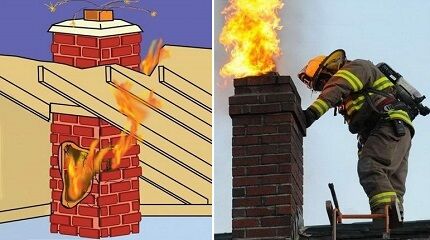
Despite the assurances of some stove makers that burning soot is safe, resorting to this method is highly discouraged. However, aspen can be successfully used as a preventive measure - it is enough to throw 2-3 kg of alder or aspen logs into the stove from time to time after finishing the fire.
We invite you to familiarize yourself with additional information about tools and methods cleaning smoke ductsoutlined in the recommended article.
Mechanical soot removal technology
The most effective method to quickly bring a chimney back to normal is mechanical cleaning. The work is labor-intensive and requires the performer to comply with a number of rules.
Chimney sweep tools and equipment
Chimney cleaning devices used many years ago are still relevant today.
Indicative list:
- A metal brush with a diameter 20-30% larger than the cross-section of the chimney. For square pipes, a stiff brush is selected.
- Cable and brush holders.
- Steel round core with cable and carabiner. The diameter of the weight is 2/3 of the chimney section.
For cleaning, it is better to choose a brush with nylon hard bristles.

Before doing dirty work, you need to take care of personal protective equipment - wear long sleeves, glasses, a respirator and gloves, and put on boots with non-slip soles.
Working Conditions: Basic Safety
It is important to take the following precautions during the cleaning process:
- The inspection hatches of the chimney must be closed so that soot does not get inside the room and spoil the finish. Cover the open fireplace with a damp cloth.
- Work is carried out in calm, dry weather.
- Be sure to use a safety rope and belt.
- It is advisable to enlist the support of one responsible assistant.
- It is strictly forbidden to start cleaning while drunk, tired, or after taking medications that slow down the reaction.
It is necessary to inspect the chimney in advance for the presence of foreign objects, for example, bird nests.
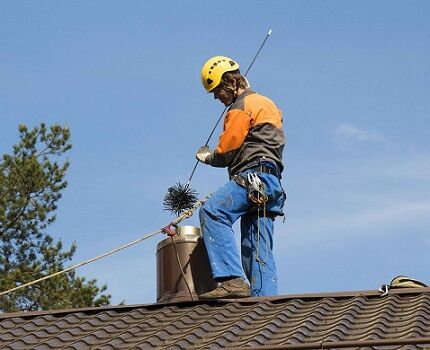
Step-by-step process of chimney cleaning
The whole process consists of several steps:
- Remove the pipe head from the top of the chimney and use a broom or long stick to remove visible dirt.
- Perform a test run with a weighting agent. The core should split large layers - small fragments will fall into the firebox.
- When the patency of the canal is restored, pull out the cable and connect the brush to the core.
- Clear a small area by lowering and raising the rope.
- Clean the rest of the chimney in the same way.
- Check the inspection chamber and remove any fallen soot.
The described technology is effective for straight chimneys - even at an angle of 45°, the passage of the core will be difficult.
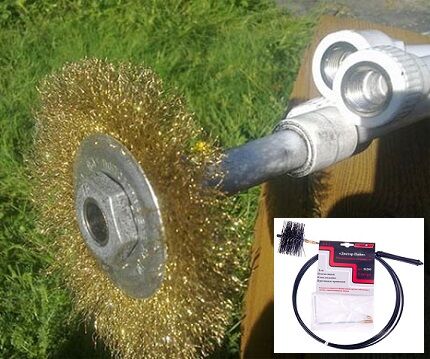
Conclusions and useful video on the topic
Comparison of the effectiveness of cleaning products (Chimney Sweeper logs, Kominicek and Cheerful Chimney Sweeper powders):
Combustion of fuel with powdered cleaner:
How to make and use a simple device for removing soot from a chimney:
It is better to entrust a full inspection and cleaning of smoke ducts to a professional specialist. You can independently carry out preventive treatment with chemical reagents, following the manufacturer’s recommendations.
Do you have your own proprietary recipe for removing soot from your chimney? Do you have any questions about unclear points in the article or want to talk about your own experience as a chimney sweep? Please write in the comments block everything you would like to tell us and site visitors about, and post photos here.




The more competently the chimney is designed, the less fuss with it later. This also applies to methods and means of care. I usually don’t buy industrial household chemicals, but clean them myself, so to speak, using folk methods. I process it manually with a metal brush or a brush - this is the most reliable way, why invent a wheel. I tried burning aspen logs, I didn’t like it at all, and it was dangerous.
Before each heating season, I hire a chimney sweep to clean the fireplace, since I myself don’t understand anything about it, but safety comes first. From what I have read, I can conclude that my specialist is doing everything correctly, and this is confirmed by the good functioning of the chimney in the fireplace. Moreover, I myself have seen several cleaning methods described above. I advise you to clean the smoke ducts regularly.
Chimney sweep "Log" is a good product, an effective cleaner for the chimney of a fireplace's boiler from soot, carbon deposits and soot. The process of the log cleaner is based on a reaction that loosens the soot layer. During the burning of a log, active oxygen and metal ions are released. Once in the chimney, they react with the components of the deposits, making them soft and pliable.
Light fractions - soot dust and soot - are drawn out through the pipe. And heavy fractions - creosote and resinous components - settle on the grate with ash. As a result of cleaning, traction increases, resulting in much increased heat transfer. And you will get the right amount of heat into the room using much less fuel.
Therefore, eliminating chimney blockages prevents fires, increases the heating effect and saves gas, wood or coal.
What is written in the advertisement is clear, can you explain in a simpler way what the advantages of this log are over ordinary aspen or potato peelings? Is there anything to pay money for?
The first advantage of industrial logs over potato peelings is their ease of use. You don’t need to prepare or dry anything, you just buy a ready-made solution. And again, all these are preventive measures, that is, if there is a lot of soot and soot in the chimney, then you will have to clean the chimney manually. The same aspen can be difficult to obtain in some regions; in this case, it is also more practical to use special logs or granules. It looks like an ordinary log, but it is impregnated with special substances that help remove soot from the chimney.
It is also worth noting that in order to avoid the formation of a lot of soot, you should not burn with resinous tree species, as well as with wood that has been used (for example, parquet boards).
In a village house you have to clean the chimneys and chimneys yourself. I only burn wood of different species, mainly a mixture of alder, aspen and birch, ash and Canadian maple, but sometimes there is a mixture of spruce and pine. Once a year, when cleaning, I take out 2 buckets of soot. The work is dirty, but not difficult if you know the location of the chimneys. It takes 2.5-3 hours + cleaning 1.5 hours + bath, so a day is spent on this dirty business. I tried the "log" but was disappointed. After reading the article, I realized that a single use does not give the desired effect.